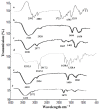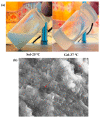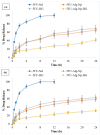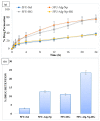Formulation and Evaluation of Chitosan-Gelatin Thermosensitive Hydrogels Containing 5FU-Alginate Nanoparticles for Skin Delivery
- PMID: 36135249
- PMCID: PMC9498398
- DOI: 10.3390/gels8090537
Formulation and Evaluation of Chitosan-Gelatin Thermosensitive Hydrogels Containing 5FU-Alginate Nanoparticles for Skin Delivery
Abstract
(1) Background: Chitosan-gelatin-based thermosensitive hydrogel containing 5FU-alginate nanoparticles was formulated for the effective and sustained delivery of 5FU to the skin. (2) Methods: Alginate, a polysaccharide was used for the formulation of nanoparticles using a spray drying technique. Size, zeta potential, and surface morphology were investigated using a zetasizer and scanning electron microscope. The hydrogel was fabricated using chitosan and gelatin. Several important analyses were used to characterize these prepared topical hydrogels. The pH, visual transparency, rheological behavior, and swelling index of the prepared hydrogels were evaluated. The in vitro release studies were performed at different pH (5.5 and 7.4) and temperature (32 and 37 °C) conditions using a Franz diffusion cell. Ex vivo permeation and in vivo studies were performed using Sprague Dawley rats. (3) Results: Results show that spherical nanoparticles were produced at sizes of 202−254 nm and with zeta potentials of −43 to −38 mV. The prepared nanoparticles were successfully incorporated into chitosan-gelatin-based hydrogels using a glycerol 2-phosphate disodium salt hydrates crosslinker. Drug polymers and excipients compatibility and formulation of hydrogels was confirmed by ATR-FTIR results. The pH of the prepared hydrogels was in accordance with the skin pH. The viscosity of prepared hydrogel increased with temperature increase and phase transition (sol-gel transition) occurred at 34 °C. The release of drug was sustained in case of nanoparticles incorporated hydrogels (5FU-Alg-Np-HG) as compared to nanoparticles (5FU-Alg-Np) and simple hydrogels (5FU-HG) (ANOVA; p < 0.05). The premature and initial burst release of 5FU was prevented using 5FU-Alg-Np-HG. The release mechanism of 5FU from the 5FU-Alg-Np-HG diffusion was followed by swelling and erosion, as suggested by Korsmeyer-Peppas model. The prepared hydrogel proved to be non-irritant. Ex vivo permeation study across rat’s skin suggests that permeability of nanoparticles (5FU-Alg-Np) was higher than the 5FU-Alg-Np-HG (ANOVA; p < 0.05). However, skin-related drug retention of 5FU-Alg-Np-HG was significantly higher than the 5FU solution, 5FU-Alg-Np, and 5FU-HG (ANOVA; p < 0.05). This was due to swelling of hydrogels in the lower layers of skin where the temperature is 37 °C. The higher concentration of 5FU in the skin is helpful for treatment of local skin cancer, such as melanoma, and actinic keratosis. In vivo results also confirmed maximum AUC, t1/2, and skin-related drug retention of 5FU-Alg-Np-HG. (4) Conclusions: Chitosan-gelatin-based hydrogels containing 5FU-Alg-Np possess exceptional properties, and can be used for the sustained delivery of 5FU for the treatment of local skin cancers.
Keywords: 5FU; alginate; chitosan; nanoparticles; skin delivery; thermosensitive hydrogels.
Conflict of interest statement
The authors declare no conflict of interest.
Figures









References
-
- Pita-López M.L., Fletes-Vargas G., Espinosa-Andrews H., Rodríguez-Rodríguez R. Physically cross-linked chitosan-based hydrogels for tissue engineering applications: A state-of-the-art review. Eur. Polym. J. 2021;145:110176. doi: 10.1016/j.eurpolymj.2020.110176. - DOI
LinkOut - more resources
Full Text Sources
Miscellaneous

